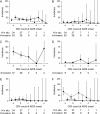Risk of human papillomavirus-associated cancers among persons with AIDS
- PMID: 19648510
- PMCID: PMC2728745
- DOI: 10.1093/jnci/djp205
Risk of human papillomavirus-associated cancers among persons with AIDS
Abstract
Background: Although risk of human papillomavirus (HPV)-associated cancers of the anus, cervix, oropharynx, penis, vagina, and vulva is increased among persons with AIDS, the etiologic role of immunosuppression is unclear and incidence trends for these cancers over time, particularly after the introduction of highly active antiretroviral therapy in 1996, are not well described.
Methods: Data on 499 230 individuals diagnosed with AIDS from January 1, 1980, through December 31, 2004, were linked with cancer registries in 15 US regions. Risk of in situ and invasive HPV-associated cancers, compared with that in the general population, was measured by use of standardized incidence ratios (SIRs) and 95% confidence intervals (CIs). We evaluated the relationship of immunosuppression with incidence during the period of 4-60 months after AIDS onset by use of CD4 T-cell counts measured at AIDS onset. Incidence during the 4-60 months after AIDS onset was compared across three periods (1980-1989, 1990-1995, and 1996-2004). All statistical tests were two-sided.
Results: Among persons with AIDS, we observed statistically significantly elevated risk of all HPV-associated in situ (SIRs ranged from 8.9, 95% CI = 8.0 to 9.9, for cervical cancer to 68.6, 95% CI = 59.7 to 78.4, for anal cancer among men) and invasive (SIRs ranged from 1.6, 95% CI = 1.2 to 2.1, for oropharyngeal cancer to 34.6, 95% CI = 30.8 to 38.8, for anal cancer among men) cancers. During 1996-2004, low CD4 T-cell count was associated with statistically significantly increased risk of invasive anal cancer among men (relative risk [RR] per decline of 100 CD4 T cells per cubic millimeter = 1.34, 95% CI = 1.08 to 1.66, P = .006) and non-statistically significantly increased risk of in situ vagina or vulva cancer (RR = 1.52, 95% CI = 0.99 to 2.35, P = .055) and of invasive cervical cancer (RR = 1.32, 95% CI = 0.96 to 1.80, P = .077). Among men, incidence (per 100 000 person-years) of in situ and invasive anal cancer was statistically significantly higher during 1996-2004 than during 1990-1995 (61% increase for in situ cancers, 18.3 cases vs 29.5 cases, respectively; RR = 1.71, 95% CI = 1.24 to 2.35, P < .001; and 104% increase for invasive cancers, 20.7 cases vs 42.3 cases, respectively; RR = 2.03, 95% CI = 1.54 to 2.68, P < .001). Incidence of other cancers was stable over time.
Conclusions: Risk of HPV-associated cancers was elevated among persons with AIDS and increased with increasing immunosuppression. The increasing incidence for anal cancer during 1996-2004 indicates that prolonged survival may be associated with increased risk of certain HPV-associated cancers.
Figures



Comment in
-
Does HIV/AIDS have a biological impact on the risk of human papillomavirus-related cancers?J Natl Cancer Inst. 2009 Aug 19;101(16):1103-5. doi: 10.1093/jnci/djp236. Epub 2009 Jul 31. J Natl Cancer Inst. 2009. PMID: 19648509 Free PMC article. No abstract available.
References
-
- Parkin DM. Bray F. Chapter 2: the burden of HPV-related cancers. Vaccine. 2006;24(suppl 3):S11–S25. - PubMed
-
- Gillison ML, Shah KV. Chapter 9: role of mucosal human papillomavirus in nongenital cancers. J Natl Cancer Inst Monogr. 2003;(31):57–65. - PubMed
-
- Grulich AE, van Leeuwen MT, Falster MO, Vajdic CM. Incidence of cancers in people with HIV/AIDS compared with immunosuppressed transplant recipients: a meta-analysis. Lancet. 2007;370(9581):59–67. - PubMed
-
- Frisch M, Biggar RJ, Goedert JJ. Human papillomavirus-associated cancers in patients with human immunodeficiency virus infection and acquired immunodeficiency syndrome. J Natl Cancer Inst. 2000;92(18):1500–1510. - PubMed
-
- Clifford GM, Polesel J, Rickenbach M, et al. Cancer risk in the Swiss HIV Cohort Study: associations with immunodeficiency, smoking, and highly active antiretroviral therapy. J Natl Cancer Inst. 2005;97(6):425–432. - PubMed
Publication types
MeSH terms
Grants and funding
LinkOut - more resources
Full Text Sources
Medical
Research Materials

